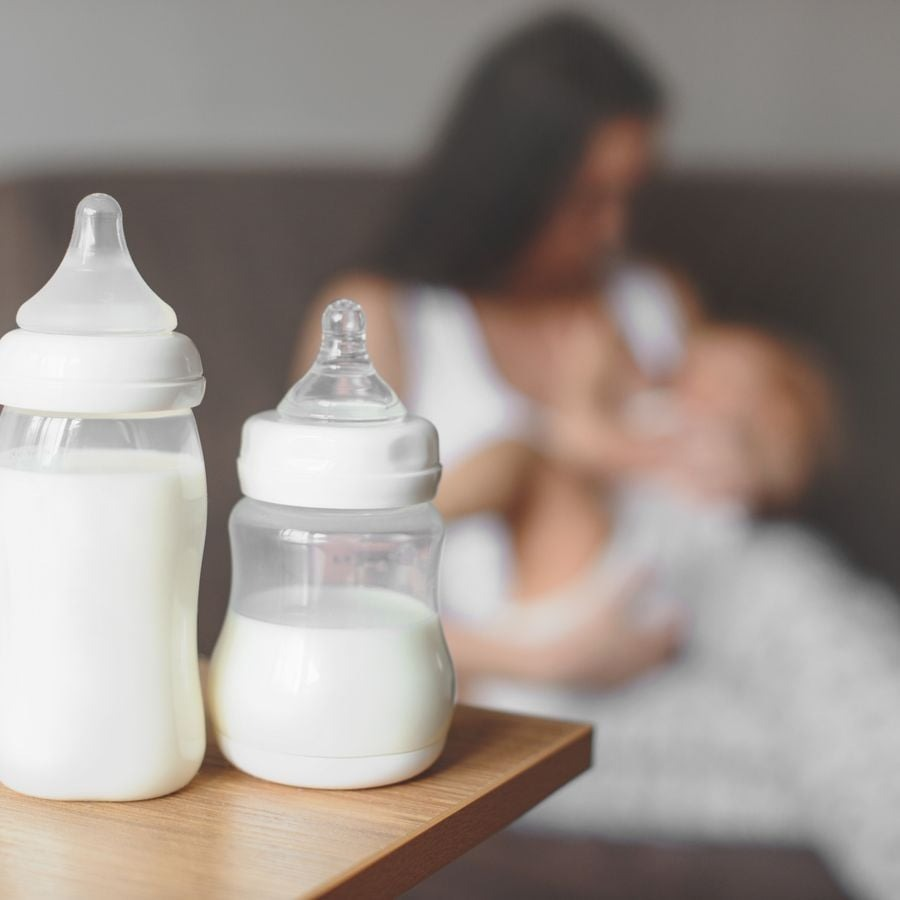
Transitioning into motherhood is transformative, replete with rewarding moments and challenges. One such challenge that often arises is ensuring proper nutrition for your newborn, particularly if you opt for bottle feeding a newborn. This guide aims to provide you with evidence-based information and practical tips to make this aspect of parenting as seamless as possible.
Why Bottle Feeding?
The choice to bottle feed can arise from various circumstances, medical conditions, lifestyle considerations, or work commitments. It’s crucial to remember that the ultimate goal is a nourished and healthy baby, regardless of the feeding method you choose.

Types of Formula
Choosing the right formula for your newborn can feel daunting, especially when you’re new to baby feeding. But don’t worry, we’ve got you covered! Here’s an in-depth look at the different types of baby formulas available, what sets them apart, and why you might choose one over the other.
Cow’s Milk-Based Formula
What Is It?
This is the most common type of baby formula made from cow’s milk that resembles breast milk.
Pros:
- Easily Digestible: Most babies can easily digest cow’s milk-based formula.
- Nourishing: It contains a balanced ratio of protein, fats, carbohydrates, and essential vitamins and minerals.
- Widely Available: You can find it in nearly every grocery store or pharmacy.
Cons:
- Not Suitable for Lactose-Intolerant Babies: If your baby has a lactose intolerance, this formula may not be suitable.
- Allergy Potential: Some babies might develop an allergy to cow’s milk protein.
Why Choose This?
If your baby has no unique particular or health concerns, cow’s milk-based formula is usually a safe and convenient choice.
Soy-Based Formula
What Is It?
Made from soy protein and free from animal products, this formula is an alternative to cow’s milk-based formulas.
Pros:
- Lactose-Free: Ideal for babies who are lactose intolerant.
- Vegetarian-Friendly: Suitable for families with vegetarian or vegan lifestyles.
Cons:
- Lower in Fat: Soy-based formulas are generally lower in fat than their cow’s milk counterparts.
- Not for Premature Babies: Due to its composition, it’s not recommended for premature or low-birth-weight babies.
Why Choose This?
If your baby is lactose intolerant or if you’re looking for a vegetarian option, soy-based formula can be a good choice.
Specialized Formula
What Is It?
These formulas are designed for babies with specific medical conditions, such as reflux, allergies, or metabolic disorders.
Pros:
- Targeted Nutrition: Provides specialized nutrients based on the baby’s medical condition.
- Easier Digestion: Formulated to be easier on your baby’s digestive system.
Cons:
- Costly: Specialized formulas are usually more expensive.
- Prescription Required: You’ll often need a doctor’s prescription to purchase it.
Why Choose This?
If your baby has a specific medical condition that requires targeted nutrition, a specialized formula is the way to go.
Organic Formula
What Is It?
Organic formulas are made from ingredients that are grown without synthetic pesticides or herbicides and are non-GMO.
Pros:
- Chemical-Free: No synthetic pesticides or herbicides are used in the ingredients.
- Non-GMO: Ingredients are not genetically modified.
Cons:
- More Expensive: Organic formulas can be costlier than other types.
- Shorter Shelf Life: Because they lack preservatives, they may have a shorter shelf life.
Why Choose This?
If you’re keen on providing an organic start for your baby and are willing to spend a bit more, this could be the formula for you.
Each type of formula comes with its own set of guidelines for preparation and storage, so always consult the packaging or your pediatrician for specific instructions. Understanding the differences between these formulas can help you make an informed decision tailored to your baby’s unique needs.

Preparing for the First Feed
Before you embark on the bottle-feeding journey, you need to be well-equipped. Here’s a comprehensive list of items you’ll require:
Baby Bottles: Opt for bottles that are BPA-free and come with anti-colic features.
Nipples: These come in various flow rates. For newborns, a slow-flow nipple is usually best.
Sterilizer: You can choose between electric sterilizers, microwave sterilizers, or the traditional boiling method.
Formula: Purchase the option that best suits your baby’s needs, as discussed in the previous section.
Bottle Warmer: While not essential, a bottle warmer can make the process more efficient, especially for nighttime feeds.
Measuring Jug and Funnel: For accurate measurement and effortless transfer of formula.
Thermal Bag: Useful for storing prepared bottles on the go.
Sterilization Process
Wash your hands thoroughly.
Dismantle the baby bottles and nipples.
Use mild soap and warm water to clean the items.
Rinse thoroughly.
Sterilize using your chosen method.
Setting Up a Bottle-Feeding Station
Choose a convenient location, preferably near the kitchen.
Use a small cabinet or cart to store all bottle-feeding essentials.
Keep a checklist to track inventory so you always have supplies.
By preparing adequately, you’ll find that bottle feeding becomes a more enjoyable and less stressful experience for you and your newborn.
The Right Technique
When it comes to the technique of how to bottle feed a newborn, holding your baby in a semi-upright position can help prevent ear infections. Test the milk’s temperature on your wrist—it should be lukewarm. Look for cues like smacking lips or turning towards the bottle to know when your baby is hungry. Pacing the feed is also essential to avoid overfeeding.

Nighttime Feeding
Navigating nighttime feedings with your newborn doesn’t have to be daunting. Prepare by setting up a “nighttime feeding station” next to your bed, complete with pre-made bottles stored in a cooler bag, a portable bottle warmer, and essential items like burp cloths and a dimmable night light. This setup ensures you have everything within arm’s reach, eliminating the need for sleepy trips to the kitchen.
For a smoother experience, consider storing the batch-preparing formula in a thermos for easy pouring. Use a double-sided cooler bag to separate fresh and used bottles, and keep a clock or timer handy to track feeding times. A soft pillow and a cozy blanket can comfort you, making the feeding process more enjoyable.
Incorporate useful tricks like color-coding bottles for different types of milk or formula and swaddling your baby before feeding to help them fall asleep more easily. With some preparation and these handy tips, you can turn nighttime feeds into a peaceful routine for you and your baby.
Monitoring Baby’s Intake
Are you wondering if your newborn is getting enough formula? On average, newborns require about 2 to 3 ounces every 3 hours. However, individual needs can vary. Key indicators of a well-fed baby include regular bowel movements, consistent weight gain, and contentment after feeding.
Consult your pediatrician for personalized advice if you notice fussiness, weight issues, or concerns. Monitoring your baby’s intake can offer valuable insights into their well-being

Cleaning and Maintenance
Each bottle and nipple should be thoroughly cleaned with warm, soapy water after each use. If you’re using formula, rinse the bottles immediately to prevent any residue from sticking.
And here’s something you might not have thought about: baby bottles don’t last forever. Over time, bottles and nipples can wear out over time, and you’ll notice signs like discoloration, cracks, or leaks.
When you see these signs, it’s time for a replacement. It’s also a good idea to have a set of bottles—some for home use and some for when you’re on the go. This way, you’re never caught off guard. So, while feeding might be the main event, keeping those bottles clean and in top shape is the behind-the-scenes work that makes it all possible.
@hunter.boumans.xoxo repeat in a week 🔁 😮💨 #babytok #bottlefeeding #formulashortage ♬ Escapism. Sped up (Official) - RAYE & 070 Shake
Common Challenges and Solutions
If your baby refuses the bottle, don’t panic. It might take some time for them to get used to it. Gas and burping are common challenges, so pause and burp your baby during feeds.
If your baby refuses the bottle and you don’t know what to do, you can always read this article that we have prepared to solve this problem. If your baby is spitting up frequently, consult your pediatrician.
Additional Resources
Navigating the world of bottle feeding can be much easier with some extra help. Here are some valuable resources that can provide further guidance and support:
Apps for Monitoring Baby’s Feeding
Baby Tracker
This app allows you to log feeding times, amounts, and types of feed (breast milk, formula, etc.). It also tracks diaper changes and sleep patterns.
Feed Baby
This app tracks feeding and includes timers to remind you when the next feeding is due. It’s handy for parents of multiple.
Glow Baby
This app offers detailed tracking of feeding, sleep, and diaper changes, and it even provides personalized insights based on the data you input.
Books for New Parents
The Baby Owner’s Manual
This book, written by Louis Borgenicht and Joe Borgenicht, offers a humorous yet informative approach to understanding your baby’s needs, including feeding.
The Pediatrician’s Guide to Feeding Babies and Toddlers
The book, by Anthony Porto and Dina DiMaggio, provides medical-based advice on feeding your child during the first few years.
Online Courses
Newborn Baby Care: The Comprehensive Guide (Udemy)
This course covers all aspects of newborn care, including bottle feeding, and offers a certificate upon completion.
Infant Nutrition: From Breastfeeding to Baby’s First Solids” (Coursera)
Stanford University offers this course and covers the nutritional needs of infants, including formula feeding.
Baby Care 101″ (Teachable)
This course offers video tutorials on various aspects of baby care, including a detailed section on bottle feeding.
These resources can offer additional insights and tips, making your bottle-feeding journey more manageable and enjoyable.
Conclusion
So there you have it: A comprehensive guide on bottle feeding a newborn. Remember, every baby is different, so getting into the groove of things might take some time. Trust your instincts, and don’t hesitate to seek professional advice when needed.
We’d love to hear your tips and experiences on bottle feeding. Feel free to share in the comments below, and remember to subscribe for more awesome parenting tips!
We wish you and your little one all the best on this incredible journey!


Leave a Reply